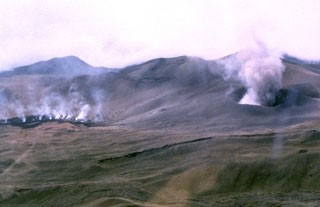Report on Cameroon (Cameroon) — October 1982
Scientific Event Alert Network Bulletin, vol. 7, no. 10 (October 1982)
Managing Editor: Lindsay McClelland.
Cameroon (Cameroon) Fissure eruption on upper SW flank; lava flow
Please cite this report as:
Global Volcanism Program, 1982. Report on Cameroon (Cameroon) (McClelland, L., ed.). Scientific Event Alert Network Bulletin, 7:10. Smithsonian Institution. https://doi.org/10.5479/si.GVP.SEAN198210-224010
Cameroon
Cameroon
4.203°N, 9.17°E; summit elev. 4095 m
All times are local (unless otherwise noted)
On 16 October, residents of Buea, ~10 km SE of the summit, were frightened by rumbling sounds and saw a red glow on the W flank. The next day, a helicopter making a survey flight over the area observed an eruption along a fissure ~6.5 km SW of the summit (on the SW border of the terminal plateau, at 4.15°N, 9.13°E). Steam was emitted from the upper part of the fissure, which began at 2,600 m altitude and trended NNE-SSW, parallel to the general tectonic trend. Basaltic lava emerged from the fissure at 2,500 m altitude and moved downslope at 20 km/hour in a 3-m-wide flow that reached forested areas. At night, glow from the lava was visible 50 km away. By 19 October, the active vent had built a cone 20 m high and 50 m in long dimension, and was emitting steam, ash, and lava fountains. Activity fluctuated 20-22 October, with periods of vigorous degassing lasting about 50 minutes. The crater included two active vents that ejected gas, ash, and bombs to 300-400 m height. Short, noisy explosions every 5-10 seconds made talking difficult 200 m from the crater. At 2450 m altitude, a lava flow poured out of the fissure at 20 km/hour. Newspapers reported some slowing of the lava advance during the night of 21-22 October, and by then the lava had moved through heavy rain forest to about 6 km from the seacoast village of Bakingili (population 300) on the SSW flank. Geologists reported that similar vent activity continued 22-30 October, and was audible 15-20 km away. On 30 October, the flow was about 200 m wide and 20 m thick, and its front had apparently stopped at 1,200 m above sea level. However, the eruption was reported to be continuing. Total lava output was estimated at 107 m3. Gas and aerosols were collected by a CNRS team. The eruption plume reached 4,000 m altitude. Total SO2 output was about 1,000 tons/day.
At press time, Fitton, Hughes, and Kilburn reported that the moderate lava outflow and Strombolian activity observed 7-8 November had declined to a very sluggish trickle on the 9th, and the eruption had apparently ended 10 November.
Most of the 300 inhabitants of Bakingili were evacuated, as were the residents of Tsonko (Isongo), a nearby coastal town. Larger towns and an oil refinery were not endangered by the current activity, but palm oil plantations have reportedly been damaged.
Geological Summary. Mount Cameroon, one of Africa's largest volcanoes, rises above the coast of west Cameroon. The massive steep-sided volcano of dominantly basaltic-to-trachybasaltic composition forms a volcanic horst constructed above a basement of Precambrian metamorphic rocks covered with Cretaceous to Quaternary sediments. More than 100 small cinder cones, often fissure-controlled parallel to the long axis of the 1400 km3 edifice, occur on the flanks and surrounding lowlands. A large satellitic peak, Etinde (also known as Little Cameroon), is located on the S flank near the coast. Historical activity was first observed in the 5th century BCE by the Carthaginian navigator Hannon. During historical time, moderate explosive and effusive eruptions have occurred from both summit and flank vents. A 1922 SW-flank eruption produced a lava flow that reached the Atlantic coast, and a lava flow from a 1999 south-flank eruption stopped only 200 m from the sea. Explosive activity from two vents on the upper SE flank was reported in May 2000.
Information Contacts: F. LeGuern, D. Polian, CNRS; B. Déruelle, F. Tchoua, Univ. of Yaoundé; Dr. Betah and Dr. Ngungi, Ministère des Mines et Energie, Yaoundé; Drs. Kergomard, Lorfsher, and Rousset, Elf Serepca, Douala; P. Vincent, Univ. de Clermont; Dr. Lonne, Ardic Cameroun Aerienne, Douala; G. Fitton, Univ. of Edinburgh; C. Kilburn, Univ. of London; D. Hughes, Portsmouth Polytechnic; Ambassador H. Horan, U.S. Embassy, Yaoundé; L. Matteson, U.S. Consulate, Douala; British Consulate, Douala; J. Baade and T. Humphrey, Gulf Oil, Douala; R. Shaw, IATA, Montreal; D. Haller, NOAA/NESS; Cameroon Tribune.

